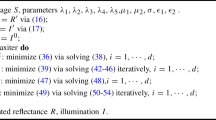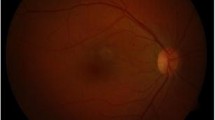Abstract
Eye diseases that are common and many diseases that result in visual ailments, such as diabetes and vascular disease, can be diagnosed through retinal imaging. The enhancement of retinal images often helps in diagnosing diseases related to retinal organ failure. However, today’s image enhancement methods may lead to artificial boundaries, sudden color gradation, and the loss of image details. Therefore, to prevent these side effects, a new method of retinal image enhancement is proposed. In this work, we propose a new method for enhancing the overall contrast of colored retinal images. That is, we propose low-light image enhancement using a new retinex method based on a powerful semidecoupled retinex method. In particular, illumination layer I gradually approximates the S input image according to the file. This leads to a complete Gaussian transformation model, while the R-layer reflectance is estimated jointly by S and intermediary by I to suppress image noise simultaneously during R estimation on the publicly available Messidor database. From our assessment measurements (PSNR and SSIM), we show that this proposed method is effective in comparison with the relevant and recently proposed retinal imaging methods; moreover, the color, which is determined by the data, does not change the image structure. Finally, a technique is presented to improve the pronounced color of a retinal image, which is useful for ophthalmologists to screen for retinal disease more effectively. Moreover, this technique can be used in the development of robotics for imaging tests to search for clinical markers.
Graphical Abstract









Similar content being viewed by others
References
Abramoff MD, Garvin MK, Sonka M (2010) Retinal imaging and image analysis. IEEE Rev Biomed Eng 3:169–208
Bolun C, Xianming X, Kailing G, Kui J, Bin H, Dacheng T (2017) A joint intrinsic-extrinsic prior model for retinex. In IEEE International Conference on Computer Vision, ICCV 2017, Venice, Italy, October 22–29,4020–4029
Chen B, Chen Y, Shao Z, Tongd T, Luo L (2016) Blood vessel enhancement via multi-dictionary and sparse coding: application to retinal vessel enhancing. Neurocomputing 200:110–117
Decenciere E et al (2014) Feedback on a publicly distributed image database: the Messidor database. Image Anal Stereol 33(3):231–234
Fenga P, Pana Y, Weia B, Jin W, Mi D (2007) Enhancing retinal image by the Contourlet transform. Pattern Recogniton Lett 28(4):516–522
Foracchia M, Grisan E, Ruggeri A (2005) Luminosity and contrast normalization in retinal images. Med Image Anal 9(3):179–190
Fu X, Liao Y, Zeng D, Huang Y, Zhang X-P, Ding X (2015) A probabilistic method for image enhancement with simultaneous illumination and reflectance estimation. IEEE transactions on image processing : a publication of the IEEE Signal Processing Society 24. https://doi.org/10.1109/TIP.2015.2474701
GeethaRamani R, Balasubramanian L (2016) Retinal blood vessel segmentation employing image processing and data mining techniques for computerized retinal image analysis. Biocybernetics Biomed Eng 36(1):102–118
Gupta B, Tiwari M (2019) Color retinal image enhancement using luminosity and quantile based contrast enhancement. Multidim Syst Sign Process 30:1829–1837. https://doi.org/10.1007/s11045-019-00630-1
Liao M, Zhao Y, Wang X, Dai P (2014) Retinal vessel enhancement based on multi-scale top-hat transformation and histogram fitting stretching. Opt Laser Technol 58:56–62
Li M, Liu J, Yang W, Sun X, Guo Z (2018) Structure-revealing low-light image enhancement via robust retinex model. IEEE Trans Image Processing : Pub IEEE Signal Proces Soc 27(6):2828–2841. https://doi.org/10.1109/TIP.2018.2810539
Pisano ED, Zong S, Hemminger BM, DeLuca M, Johnston RE, Muller K et al (1998) Contrast limited adaptive histogram equalization image processing to improve the detection of simulated spiculations in dense mammograms. J Digit Imaging 11(4):193–200
Rudin LI, Osher S, Fatemi E (1992) Nonlinear total variation based noise removal algorithms. Phys D 60:259–268. https://doi.org/10.1016/0167-2789(92)90242-F
Seoud L, Hurtut T, Chelbi J, Cheriet F, Langlois JMP (2016) Red lesion detection using dynamic shape features for diabetic retinopathy screening. IEEE Trans Med Imaging 35(4):1116–1126. https://doi.org/10.1109/TMI.2015.2509785
Sevik U, Kose C, Berber T, Erdol H (2014) Identification of suitable fundus images using automated quality assessment methods. J Biomed Opt 19(4):046006
Somkuwar AC, Patil TG, Patankar SS, Kulkarni JV (2015) Intensity features based classification of hard exudates in retinal images. In 2015 annual IEEE India conference (INDICON), New Delhi (1–5). https://doi.org/10.1109/INDICON.2015.7443402
Wang S, Zheng J, Hu HM, Li B (2013) Naturalness preserved enhancement algorithm for non-uniform illumination images. IEEE Trans Image Process 22(9):3538–3548
Wu X, Dai B, Bu W (2016) Optic disc localization using directional models. IEEE Trans Image Proces 25(9):4433–4442. https://doi.org/10.1109/TIP.2016.2590838
Yue H, Yang J, Sun X, Hou C (2017) Contrast enhancement based on intrinsic image decomposition. IEEE Transactions on Image Processing. 1–1. https://doi.org/10.1109/TIP.2017.2703078
Zhang Q, Yuan G, Xiao C, Zhu L & Zheng W (2018) High-quality exposure correction of underexposed photos. Proceedings of the 26th ACM international conference on Multimedia
Zhou M, Jin K, Wang S, Ye J, Qian D (2018) Color retinal image enhancement based on luminosity and contrast adjustment. IEEE Trans Biomed Eng 99:1
Author information
Authors and Affiliations
Corresponding author
Additional information
Publisher's note
Springer Nature remains neutral with regard to jurisdictional claims in published maps and institutional affiliations.
Rights and permissions
Springer Nature or its licensor (e.g. a society or other partner) holds exclusive rights to this article under a publishing agreement with the author(s) or other rightsholder(s); author self-archiving of the accepted manuscript version of this article is solely governed by the terms of such publishing agreement and applicable law.
About this article
Cite this article
WangNo, N., Pichai, S. Enhancing retinal images in low-light conditions using semidecoupled decomposition. Med Biol Eng Comput 61, 1795–1805 (2023). https://doi.org/10.1007/s11517-023-02811-4
Received:
Accepted:
Published:
Issue Date:
DOI: https://doi.org/10.1007/s11517-023-02811-4




